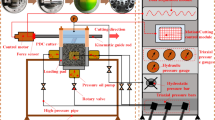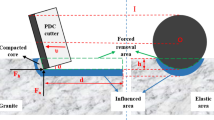Abstract
Mechanical rock cutting is one kind of rock breaking methods which is extensively used in oil gas drilling engineering. The force response and chip formation in rock cutting process plays an important role in studying the rock breaking mechanism of polycrystalline diamond compact (PDC) cutter, which is essential to the determination of optimum cutting parameters. In this paper, the experimental setup and discrete element model of rock cutting are developed; the force response and chip formation under various depths of cut (DOC), cutting velocities, and rake angles of PDC cutter are performed. This study shows that the average cutting force is proportional to the DOC when it is shallow; however, the average cutting force tends to deviate from the linear relationship while the DOC reaches to a threshold value. The cutting chips generated during rock cutting process can be divided into three parts, the crushed zone near the cutter tip and the plastic flow zone in front of the cutter surface, both of them in a powdery form, and another is the main part of chip in front of the crushed zone in a block-shaped form. The crushed zone will create a wedging effect on the initiation of macro-crack which causes the propagation of macro-crack in an opening mode. The cutting velocity has no obvious influence on the size and number of the formed chips. The smaller the rake angle is, the smaller size the chips will be. The research results are of great significance for deep understanding of the mechanism of rock cutting and for guiding the design of PDC bit and optimization of the drilling parameters.

















Similar content being viewed by others
References
Block G, Jin H (2009) Role of failure mode on rock cutting dynamics. SPE Annual Technical Conference and Exhibition. Society of Petroleum Engineers. SPE-124870-MS. https://doi.org/10.2118/124870-MS
Che D, Han P, Peng B et al (2014) Finite element study on chip formation and force response in two-dimensional orthogonal cutting of rock[C]. ASME 2014 International Manufacturing Science and Engineering Conference collocated with the JSME 2014 International Conference on Materials and Processing and the 42nd North American Manufacturing Research Conference. American Society of Mechanical Engineers, V002T02A038-V002T02A038
Chen X, Miedema SA, van Rhee C (2014) Numerical Methods for Modeling the Rock Cutting Process in Deep Sea Mining[C]. ASME 2014 33rd International Conference on Ocean, Offshore and Arctic Engineering. American Society of Mechanical Engineers, V003T10A002-V003T10A002
Chen S, Grosz G, Anderle S, Arfele R, Xun K (2016) The role of rock-chip removals and cutting-area shapes in polycrystalline-diamond-compact-bit design optimization. SPE Drilling & Completion 30:334–347. https://doi.org/10.2118/171833-PA
Da Fontoura SAB, Inoue N, Martinez IMR, Cogollo C, Curry DA (2011) Rock mechanics aspects of drill bit rock interaction. In 12th ISRM Congress. International Society for Rock Mechanics. https://doi.org/10.1201/b11646-389
Dagrain F, Detournay E, Richard T (2001) Influence of cutter geometry in rock cutting[C]. DC Rocks 2001, The 38th US Symposium on Rock Mechanics (USRMS). American Rock Mechanics Association, ARMA-01-0927
Gerbaud L, Menand S, Sellami H (2006) PDC Bits : All comes from the cutter rock interaction. IADC/SPE Drilling Conference, Feb 2006, Miami, United States. pp 1. https://doi.org/10.2118/98988-MS
Grima MA, Miedema SA, van de Ketterij RG, Yenigül NB, van Rhee C (2015) Effect of high hyperbaric pressure on rock cutting process. Eng Geol 196:24-36
Hareland G, Nygaard R, Yan W, Wise JL (2009) Cutting efficiency of a single PDC cutter on hard rock. Journal of Canadian Petroleum Technology 48:60–65. https://doi.org/10.2118/09-06-60
Helmons RL, Miedema SA, van Rhee C (2014) A new approach to model hyperbaric rock cutting processes. OMAE 2014, 9. https://doi.org/10.1115/OMAE2014-23671
Huang H, Detournay E (2008) Intrinsic length scales in tool-rock interaction. International Journal of Geomechanics 8(1):39–44. https://doi.org/10.1061/(ASCE)1532-3641(2008)8:1(39)
Huang HY, Lecampion B, Detournay E (2013) Discrete element modeling of tool-rock interaction I: rock cutting. International Journal for Numerical and Analytical Methods in Geomechanics 37(13):1913–1929
Kaitkay P, Lei S (2005) Experimental study of rock cutting under external hydrostatic pressure. Journal of Materials Processing Technology 159:206–213. https://doi.org/10.1016/j.jmatprotec.2004.04.418
Ledgerwood III LW (2007) PFC modeling of rock cutting under high pressure conditions. In 1st Canada-US Rock Mechanics Symposium. American Rock Mechanics Association. https://doi.org/10.1201/NOE0415444019-c63
Lei ST, Kaitkay P (2003) Distinct element modeling of rock cutting under hydrostatic pressure. In Key Engineering Materials 250:110–117. https://doi.org/10.4028/www.scientific.net/KEM.250.110
Li XB, Summers DA, Rupert G, Santi P (2001) Experimental investigation on the breakage of hard rock by the PDC cutters with combined action modes. Tunnelling and Underground Space Technology 16:107–114. https://doi.org/10.1016/S0886-7798(01)00036-0
Lin JS, Mendoza JA, Gamwo IK, Jaime MC, Zhou Y, Brown J, Zhang W (2011) Numerical modeling of rock cutting. In 12th ISRM congress. International Society for Rock Mechanics. https://doi.org/10.1201/b11646-79, Numerical modeling of rock cutting
Liu W, Zhu X, Jing J (2018) The analysis of ductile-brittle failure mode transition in rock cutting. Journal of Petroleum Science and Engineering 163:311–319
Liu W, Qian X, Li T, Zhou Y, Zhu X (2019) Investigation of the tool-rock interaction using Drucker-Prager failure criterion. J Pet Sci Eng 173:269–278. https://doi.org/10.1016/j.petrol.2018.09.064
Ma Y, Huang H (2014) DEM analysis of using the scratch test to probe rock heterogeneity. In Rock Mechanics and Its Applications in Civil, Mining, and Petroleum Engineering:198–207. https://doi.org/10.1061/9780784413395.023
Menezes PL, Lovell MR, Lin JS, III CFH (2009) Finite element modeling of discontinuous chip formation during rock cutting. In ASME Conference Proceedings:463–465. https://doi.org/10.1115/IJTC2009-15197
Menezes PL, Lovell MR, Avdeev IV, Higgs CF (2014a) Studies on the formation of discontinuous rock fragments during cutting operation. International Journal of Rock Mechanics and Mining Sciences 71:131–142. https://doi.org/10.1016/j.ijrmms.2014.03.019
Menezes PL, Lovell MR, Avdeev IV, Lin JS, Higgs CF (2014b) Studies on the formation of discontinuous chips during rock cutting using an explicit finite element model. The International Journal of Advanced Manufacturing Technology 70:635–648. https://doi.org/10.1007/s00170-013-5309-y
Meng F Z, Wong L N Y, Zhou H, et al (2019) Shear rate effects on the post-peak shear behaviour and acoustic emission characteristics of artificially split granite joints. Rock Mechanics and Rock Engineering, 1–20
Miedema SA, Zijsling D (2012) Hyperbaric rock cutting[C]. ASME 2012 31st International Conference on Ocean, Offshore and Arctic Engineering. American Society of Mechanical Engineers, 103–116. https://doi.org/10.1115/OMAE2012-83249
Rafatian N, Miska SZ, Ledgerwood LW, Yu M, Ahmed R, Takach NE (2010) Experimental study of MSE of a single PDC cutter interacting with rock under simulated pressurized conditions. SPE Drilling & Completion 25(01):10–18. https://doi.org/10.2118/119302-PA
Rajabov V, Miska SZ, Mortimer L, Yu M, Ozbayoglu ME (2012) The effects of back rake and side rake angles on mechanical specific energy of single PDC cutters with selected rocks at varying depth of cuts and confining pressures. In IADC/SPE Drilling Conference and Exhibition. Society of Petroleum Engineers. https://doi.org/10.2118/151406-MS
Richard T, Coudyzer C, Desmette S (2010) Influence of groove geometry and cutter inclination in rock cutting. In 44th US Rock Mechanics Symposium and 5th US-Canada Rock Mechanics Symposium. American Rock Mechanics Association, ARMA-10-429
Richard T et al (2012) Rock strength determination from scratch tests. Eng Geol 147:91–100. https://doi.org/10.1016/j.enggeo.2012.07.011
Rojek J, Onate E, Labra C, Kargl H (2011) Discrete element simulation of rock cutting. International Journal of Rock Mechanics and Mining Sciences 48:996–1010. https://doi.org/10.1016/j.ijrmms.2011.06.003
Sunal O (2009) Parametric study of a single PDC cutter with a numerical model. West Virginia University.
Tulu IB (2009) Modeling PDC cutter rock interaction. West Virginia University.
Tulu IB, Heasley KA (2009) Calibration of 3D cutter-rock model with single cutter tests. In 43rd US Rock Mechanics Symposium & 4th US-Canada Rock Mechanics Symposium. American Rock Mechanics Association, ARMA-09-160
Van Wyk G, Els DNJ, Akdogan G, Bradshaw SM, Sacks N (2014) Discrete element simulation of tribological interactions in rock cutting. Int J Rock Mech Min Sci 65:8–19. https://doi.org/10.1016/j.ijrmms.2013.10.003
Yang YX (2003) Research on cutting mechanics of PDC bit. Southwest Petroleum University.
Zhu RQ (2016) International advancement of drilling bits for oil and gas well (3)-PDC bits progress and present trend. Exploration Engineering (Rock & Soil Drilling and Tunneling) 43:1–8
Zhu X, Liu W, He X (2017) The investigation of rock indentation simulation based on discrete element method. KSCE Journal of Civil Engineering 21(4):1201–1212
Acknowledgments
Financial supports are greatly appreciated by the authors.
Funding
This study is supported by the China Postdoctoral Science Foundation (2018 M633403), Scientific Research Starting Project of SWPU (2018QHZ015), Applied Basic Research of Sichuan Province (Free Exploration-2019YJ0520), National Natural Science Foundation of China (51674214), Youth Science and Technology Innovation Research Team of Sichuan Province (2017TD0014).
Author information
Authors and Affiliations
Corresponding author
Additional information
Editorial handling: F. Dai
Rights and permissions
About this article
Cite this article
Liu, W., Zhu, X. Experimental study of the force response and chip formation in rock cutting. Arab J Geosci 12, 457 (2019). https://doi.org/10.1007/s12517-019-4585-8
Received:
Accepted:
Published:
DOI: https://doi.org/10.1007/s12517-019-4585-8




